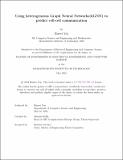Using heterogeneous Graph Neural Networks(hGNN) to predict cell-cell communication
Author(s)
Yan, Binwei
DownloadThesis PDF (4.453Mb)
Advisor
Kellis, Manolis
Terms of use
Metadata
Show full item recordAbstract
This thesis investigates diverse computational methodologies for modeling cellular interactions using single-cell RNA sequencing (scRNA-seq) data. We evaluate the performance of Graph Neural Networks (GNNs) both with and without gene-gene edges, Contrastive Learning, and Variational Autoencoders (VAEs) across multiple datasets. Our study compares these methods and establishes benchmarks for assessing their effectiveness beyond traditional case studies. By integrating extensive signaling pathway data, we aim to unveil complex cell-cell communication patterns and regulatory mechanisms that conventional scRNA-seq analysis methods might overlook. Our approach emphasizes the use of spatial data as a crucial indicator, facilitated by the advanced capabilities of heterogeneous GNNs to model physical proximity. We found that our analysis of the functioning genes aligns with previous findings, proving our model’s effectiveness as a potential method for further analyze communication mechanisms.
Date issued
2024-05Department
Massachusetts Institute of Technology. Department of Electrical Engineering and Computer SciencePublisher
Massachusetts Institute of Technology